Carnage!
Carnage features 3 new pieces that capture or attack the enemy not by displacement but by 4 different methods: The Terror Freeze immobilizes all surrounding pieces, the Dragon captures by approach or by withdrawal and the Detonator detonates all surrounding pieces without moving.
The game also includes Knights with additional stepping powers, and a special stronger type of pawn.
Carnage adds much of the tactical gameplay of Rococo to that of Chess since the new pieces: the Terror Freeze and the Dragon are derived from the Advancer, Withdrawer and Immobilizer.
Carnage is a sister game to Wreckage, having an identical start configuration and differing only by the piece that is dropped during play: the Terror Freeze instead of the Flying Guillotine.
-
Carnage features:
- The Dragon, which moves passively like a queen or knight but captures by forward advance and by lateral and rear withdrawal. It cannot capture pawns or ninja pawns.
- The Terror Freeze moves passively like a queen or knight and immobilizes adjacent pieces. It too cannot affect pawns or ninja pawns. One piece per side can be dropped into an empty space of the back rank during play.
- The Detonator moves passively like a queen or knight and detonates (captures) all pieces except ninja pawns that are adjacent or surrounding it. It cannot detonate ninja pawns but it can detonate regular pawns.
- A Ferz Knight and wazir knight replace the regular knights.
- Pawns are speeded up considerably, and can move 1-3 spaces forward to the center (rank 5 for white, rank 6 for black) in one move at any turn. Once in enemy half of board they can move 1 or 2 spaces forward.
- 5 Ninja pawns can be dropped during play and pushed forward on the same turn. These are like pawns, but enhanced with the power to move 1 space sideways passively, and to also capture 1 space sideways on enemy half of board.
- Flexible Castling allows a side to choose the squares where the king and rook should be placed.
Board Setup
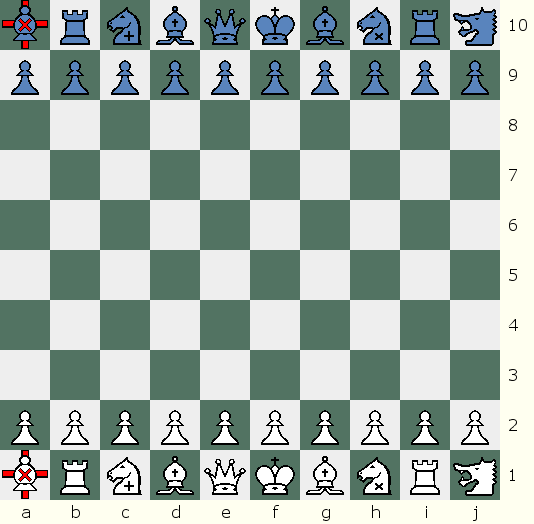 |
 




|
|
Carnage Start position
Coordinates for white. (black mirrors white) Detonator on a1 Dragon on j1 Rooks on b1,i1 Wazir-Knight on c1 Ferz-Knight on h1 Bishops on d1, g1 Queen on e1 King on f1 Pawns from a2- j2 One Terror Freeze to be dropped in empty space from a1-j1 5 Ninja Pawns to be dropped in empty space from a2-j2 |
 



 |
The Pieces
The standard pawn
Moves exactly as in standard chess except:The pawn can move 1-3 spaces towards the center during any turn.
It can move from its original position 1, 2 or 3 vacant squares forward, or if its first move was only 1 space forward or if it captured from its start position, it can move forward 1 or two spaces towards the center.
En-passant is logically applied to meet these changes.
From the middle (rank 5 for white, rank 6 for black), it can step only 1 space forward into the upper half of board, but from thereafter it can go one or two vacant spaces forward.
For example, a pawn can start at e2 push forward to e5 then make one step to e6 then go e8, and promote at e10 in 4 moves!
Note that if a pawn makes the two step pawn move and bypasses an enemy pawn, it can be captured en-passant.
see rules for more info.
The Ferz-Knight - moves like a knight or makes one step diagonally.
The Wazir-Knight - moves like a knight or makes one step orthogonally.
The Dragon


- It can move without capturing like a Queen or a Knight.
-
It can capture the enemy piece by approaching along an unobstructed path in forward directions N, NE and NW only and stopping one square short.
It is mandatory to make the capture if this move is carried out. - It can also capture by withdrawing 1 or more spaces away from an adjacent enemy piece along an unobstructed path in the directions S, E, W, SE and SW.
(Backwards and sideways).
It is mandatory to make the capture if this move is carried out i.e you cannot witdraw backwards and sideways from an enemy piece and not capture. - It CANNOT capture Pawns or Ninja Pawns under any circumstance.
- It NEVER captures by replacement.
- It can NEVER capture when jumping. It can only jump like a knight when not capturing.
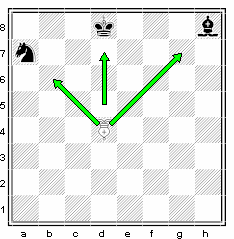
|
Here the Dragon can capture the bishop and knight by advancing towards them.
It is also checking the black king. |
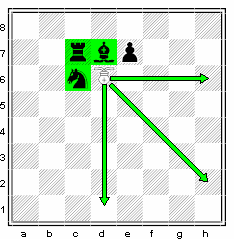 |
Here the Dragon can capture the rook, knight and bishop by withdrawing from them as shown.
It cannot capture the pawn by withdrawing. The Dragon can also slide like a queen or jump like a knight to any square without capturing. However capturing is not optional, i.e. in diagram it can only move without capturing along the line d6-a3. |
The Detonator


- It can move without capturing like a Queen or a Knight.
-
It can capture all adjacent pieces without moving, and this detonation counts as 1 turn.
Note that it must either capture ALL adjacent pieces or none at all; there is no choice of which to capture.
The detonation counts as one turn. - It cannot capture Ninja Pawns. Note that it CAN detonate standard pawns.
- It cannot capture by replacement, and it never captures by moving.
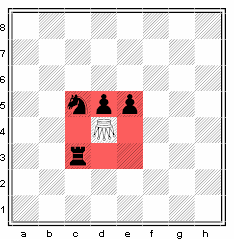 |
The Detonator shown can capture any piece on the red squares. It does not move when capturing. |
The Terror Freeze


- Movement: The Terror Freeze moves without capturing like a queen or a knight.
- Freezing/Immobilizing: All surrounding pieces except pawns and ninja pawns are completely immobilized being unable to neither move nor capture. These immobilized pieces cannot deliver check either. They can only be freed if the enemy Terror Freeze is captured or simply moves away. Two Terror Freeze pieces next to each other freeze each other and all other surrounding pieces as well. A frozen detonator cannot detonate any adjacent pieces. A king that is frozen can be checkmated by any attacking enemy piece including the enemy king!
- Dropping: One Terror Freeze can be dropped by each side into an empty space on the back rank. The drop is considered a turn; must wait until next turn to move it.
-
Castling:
Unlike standard Chess, castling is flexible with the king able to travel 1, 2, 3, or 4 squares towards the rook.
There are 7 possible castling positions, the most extreme wing castling involves the king relocating to the b or i file. The choice of castling positions will depend on whether it is immediately necessary for the king to be tucked away at the wing or for the rook to be centralized.
The usual castling criteria apply: No piece can occupy the spaces travelled by the king and castling rook. Cannot castle out of check. King cannot pass over or land on squares attacked by enemy, but rook can.-
1 space transposition - King Side Castling
White moves King one space from f1-g1 and rook from i1-f1
Black moves King one space from f10-g10 and rook from i10-f10 -
1 space transposition - Queen Side Castling
White moves King one space from f1-e1 and rook from b1-f1
Black moves King one space from f10-e10 and rook from b10-f10 -
2 space transposition - King Side Castling
White moves King two spaces from f1-h1 and rook from i1-g1
Black moves King two spaces from f10-h10 and rook from i10-g10 -
2 space transposition - Queen Side Castling
White moves King two spaces from f1-d1 and rook from b1-e1
Black moves King two spaces from f10-d10 and rook from b10-e10 -
3 space transposition - King Side Castling
White moves King three spaces from f1-i1 and rook from i1-h1
Black moves King three spaces from f10-i10 and rook from i10-h10 -
3 space transposition - Queen Side Castling
White moves King three spaces from f1-c1 and rook from b1-d1
Black moves King three spaces from f10-c10 and rook from b10-d10 -
4 space transposition - Queen Side Castling
White moves King four spaces from f1-b1 and rook from b1-c1
Black moves King four spaces from f10-b10 and rook from b10-c10
Any other piece can occupy j1, j10, a10 or a1 during castling. -
1 space transposition - King Side Castling
- Fast Pawns: As described before, the Pawns can at any time move multiple spaces forward to reach the center. Then they can step forward just one step to enter enemy territory and thererefter move 1 or 2 spaces forward.
-
En-Passant:
A pawn can capture en-passant any enemy pawn that on the last move made multiple steps and bypassed it.
Ninja Pawns cannot be captured by En Passant nor can they capture En Passant. - Pawn promotion: Pawns or Ninja Pawns can now promote to: Queen, Bishop, Ferz Knight, Wazir Knight, Rook, Dragon, Terror Freeze or Detonator. on the 10th rank only.
- Dropping: 5 Ninja Pawns and 1 Terror Freeze can be dropped by either side during the turn.
Ninja pawns can dropped into any empty space on the second rank and make an optional forward thrust in the same turn.
The Terror Freeze can be dropped into any empty space on the back rank, but it cannot be moved on the same turn. - Rules of stalemate and checkmate are as in orthodox chess, and extended to account for the frozen scenarios. If either side cannot make a legal move or drop a piece whether because their pieces are immobilized and/or doing so would place the king in check, then it is stalemate. A king cannot be adjacent to an enemy king except in the case of the enemy king being immobilized, and then this condition is checkmate.
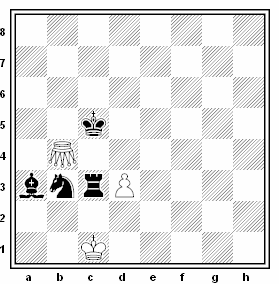 |
The Terror Freeze on b4 has frozen all of blacks pieces and it seems that the white king has moved into check somehow. But this is not the case since each black piece is frozen and is therefore immobilized. If it is black's turn to move then it is stalemate. But if it is white's turn to move: pawn d3-d4 is mate! |
The Ninja Pawn


Movement:
The ninja pawn can always move 1 square up or 1 square sideways
to an empty square regardless of where it is situated on the board.
Thus White can on each turn move from e2-e3, e3-d3 and d3-d5.
From the middle exactly, (rank 5 for white, rank 6 for black), the ninja pawn can move only 1 square forward, but thereafter as soon as it enters enemy territory (the upper half of the board: White rank 6-10, and for black rank 5 - 1), the pawn can go forward either 1 OR 2 empty spaces.
Capture:
Like the standard pawn it can capture one square diagonally up, regardless of which half of the board it is on.
When the ninja pawn is on the top half of board (White rank 6 +, Black rank 5-) , it can also capture one square horizontally.
There is no en passant. It cannot capture another pawn or ninja pawn en passant nor can any other pawn capture it this way.
Promotion:
The ninja pawn promotes on the last row (rank 10 for white, rank 1 for black), to any piece. Promotion to a piece is mandatory so it would cease to be a pawn
in the last row.
Note that like the standard pawn, it can reach the promotion square from its start position in a minimum of 4 moves!
It cannot make a capture on the same turn as the drop.
Rules
The Invisible River / the thin red line and pawn/ninja pawn movement
In orthodox chess, the middle of the board is rank 4 for white and rank 5 for black. The pawns are allowed to reach the middle in one move and then just proceed one step at a time.Unlike Chinese Chess, there is no "River" but this middle is still significant.
In Carnage the middle can be described as a thin red line or an invisible river, and crossing it results in a change for both ninja pawns and pawns. For starters, once they make the single step into enemy territory, the pawns can move forward one or two steps and threaten to promote very quickly. Additionally, the Ninja Pawns gain the ability to capture sideways.
Thus, it can be seen that the middle part of the board plays a very important part in a player's strategy, for crossing it leads to enhanced powers of both pawns and ninja pawns.
Carnage Checkmate/Stalemate Problem
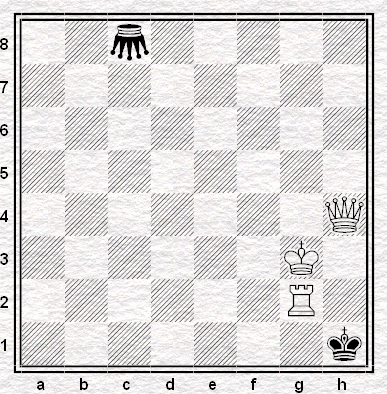
|
Black can draw! Amazing and it seems that white has already mated Black! But even more incredibly can Black win?!!! Assume that both sides have no other pieces left and no pieces to drop. (for simplicity a smaller board than what is used for game is shown) |
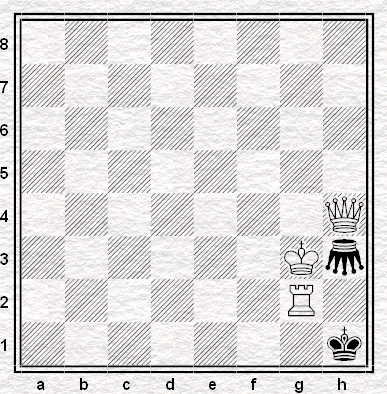
|
Black draws with c8-h3! But even more incredibly can Black win?!!! What if black plays c8-g4 instead?! Then the White queen and king are still frozen, so the black king is still out of check. Now if white mistakenly checks by g2-h1+ then black plays kxr mate! Another possible mistake by white, playing g2-g1 check expecting kxr stalemate, but instead black plays k h1-h2 mate! But if white moves the rook away say to a2, then black king cannot move to the second rank and must play to g1. But, if white checks at a1 then black plays g1 -g2 mate!! By no means is this forced since white can simply keep moving rook along the second rank preventing the king from checkmating. On the normal 10x10 board though white might make another mistake- move to to j2 with the idea of playing j2-j3 attacking the Terror Freeze but Black will then be able to checkmate with king. This peculiarity with the king being able to deliver checkmate may catch many beginners offguard. |
Play the Game!
Play Carnage! (Free Registration at chessvariants.org required).View Game Logs for Carnage
 Download Zillions of Games File
Download Zillions of Games File
Other notes
|
If you would like to email the chess variant inventor directly: inventor@chess.computerwebservices.net
|

